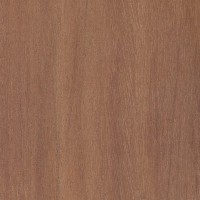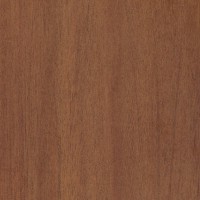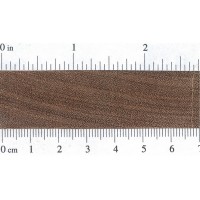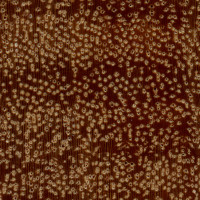 |
Common Name(s): Cumaru, Brazilian Teak Scientific Name: Dipteryx odorata Distribution: Northern South America Tree Size: 130-160 ft (40-50 m) tall, 3-5 ft (1-1.5 m) trunk diameter Average Dried Weight: 68 lbs/ft3 (1,085 kg/m3) Specific Gravity (Basic, 12% MC): .86, 1.09 Janka Hardness: 3,330 lbf (14,800 N) Modulus of Rupture: 25,390 lbf/in2 (175.1 MPa) Elastic Modulus: 3,237,000 lbf/in2 (22.33 GPa) Crushing Strength: 13,850 lbf/in2 (95.5 MPa) Shrinkage: Radial: 5.3%, Tangential: 7.7%, Volumetric: 12.6%, T/R Ratio: 1.5 |
Color/Appearance: Heartwood tends to be a medium to dark brown, sometimes with a reddish or purplish hue; some pieces may have streaks of yellowish or greenish brown.
Grain/Texture: Grain is interlocked, with a medium texture and a waxy feel.
Endgrain: Diffuse-porous; solitary and radial multiples; large pores in no specific arrangement, few; heartwood mineral/gum deposits present; parenchyma lozenge, aliform, confluent, and sometimes marginal; narrow rays, normal to close spacing.
Rot Resistance: Cumaru has excellent durability and weathering properties. The wood is rated as very durable regarding decay resistance, with good resistance to termites and other dry-wood borers.
Workability: Tends to be difficult to work on account of its density and interlocked grain. If the grain is not too interlocked, Cumaru can be surface-planed to a smooth finish. However, the wood contains silica and will have a moderate blunting effect on tool cutters. Due to its high oil content and density, Cumaru can present difficulties in gluing, and pre-boring is necessary when screwing or nailing the wood.
Odor: Cumaru has a faint, vanilla or cinnamon-like odor when being worked.
Allergies/Toxicity: Besides the standard health risks associated with any type of wood dust, no further health reactions have been associated with Cumaru. See the articles Wood Allergies and Toxicity and Wood Dust Safety for more information.
Pricing/Availability: Should be inexpensive for an import. Cumaru, much like Jatoba, represents a great value for those seeking a low-cost lumber that has excellent strength and hardness properties.
Sustainability: Cumaru is listed in CITES Appendix II under a blanket restriction covering all Dipteryx species. However, Dipteryx odorata in particular is currently not included on the IUCN Red List of Threatened Species and is reported as being data deficient.
Common Uses: Flooring, cabinetry, furniture, heavy construction, docks, railroad ties, bearings, handles, and other turned objects.
Comments: Wood of the species Dipteryx odorata is most commonly called Cumaru among most woodworkers, though it is sometimes referred to as Brazilian Teak as well: primarily when used as hardwood flooring. (Brazilian Teak is not related to the wood that is most commonly called Teak, Tectona grandis.)
Cumaru is also called by the name Tonka Bean, and the tree is commonly cultivated for its vanilla-cinnamon scented seed—the tonka bean—which contains a chemical compound called coumarin.
Cumaru lumber is extremely stiff, strong, and hard, lending itself well to a variety of applications. It is sometimes used in place of the much more scarce Lignum Vitae.
The heartwood fluoresces under a blacklight, which can help distinguish it from Ipe.
None available.





I have just bought 2” cumaru boards and want to make a tabletop. There are some cracks at the ends. Is it possible to fill it with epoxy at first? I don’t want to throw away the beginning and end of the board with cracks. What epoxy is better to use?
For example my first table made of cumaru.
I just watched a video of Anton Petrof on YouTube, a no BS science news communicator who reads actual scientific papers:
New Info on this tree is that it doesn’t only seam to survive all lightning strikes, but it attracts and uses them as a defense mechanism to kill off other plants/tree species nearby that are invasive to it and/or it’s competing with! Smart freaking tree!
What wood is this
Is Cumaru safe for smoking/cooking meats?
look up smoking woods specifically for the purpose, since the toxicity stuff will be more accurate and extensive for it being consumed or the smoke breathed in by us, and can be a totally different health risk than using it for wood working, as combustion can alter chemistry greatly.
I can see you are thinking of it’s semi sweet vanilla/cinnamon smell, and if OK may just make for some great taste, and I totally dig that, but then again it would probably already be marketed as such for a few decades if that were the case, so there’s that.
Hi all, I’m a wood flooring contractor in Massachusetts. I’m contracted to match an existing hard wood floor with new material. The wood distributor and general contractor believed the existing wood floor to be santos mahogany. But upon delivery it was clear that either the grade or species was not a match. The wood was returned. Further conversation between myself and the wood distribution staff yielded no results. My own research since leads me to believe the existing floor is either Clear Grade Cumaru or Rustic Grade Jatoba. Though I’m leaning towards Cumaru. I’ve contacted the u.s forestry service for… Read more »
I don’t think it is Jatoba – not reddish enough. Looks like cumaru.
could be sapele
My parents’ house has jatoba flooring. It’s a dark to very dark reddish color, nothing like the one in the photos. I have some sapelli doors and wooden planks, also reddish. It’s definitely not sapele or jatoba.
I am considering buying a bench topped with cumaru wood. Living in AZ, I am not convinced any wood would stand up to our intense sun and dry weather. Suggestions?
I’m going to try Cumaru for guitar fretboard on my next build. Is anyone already try it for fretboard?
Osmo Polyox = cheap soybean oil + 50% naptha + siccatives similar to PU + candelilla wax (from CITES II endangered Candelilla) = greenwashed utter rubbish. Tung oil is the best but hard to apply and long drying times, also no matting agent so would require wire brushing for matting. We can get pure Tung oil here in the UK and Liberon do a quick drying version which contains naptha and some siccatives but is quite pure. Some finishes contain UV inhibitors but are really applied too thinly to have an efficient effect (would need to be as thick as… Read more »
Can I use cumaru wood to make a chopping block?
what kind of finish can u put on railing that get a lot of sunI’m considering cumaru solid wood flooring for our upcoming kitchen-dining room renovation. It comes already factory-finished, which I hate for the plasticky look and feel – our house is already full of that stuff. I’d rather walk on wood than polyurethane. So we’re thinking of installing it and then sanding off the finish and having it oiled afterward (Bona penetrating oil?), but I’m wondering: does it even need oiling? Since it’s so oily already and so dense that trying to get any oil to soak in could be an exercise in frustration anyway? It would be well-protected from UV, but… Read more »
I’ll reply to myself with what I’ve found out over the past week or so. Yes, cumaru should be sealed despite its high oil content. I’ve found a place to get unfinished cumaru — also found out that some “pure vegetable oil based” penetrating oils actually contain polyurethane resins and petroleum distillates. It may be that only Osmo Polyx oils don’t have these, and I’ve used Osmo myself many times on wood projects. I also found out about water-popping, and that I’ve done the equivalent when I pretreat the wood with limonene and then apply a 50-50 mix of limonene… Read more »
Hi William, I live in the NW as well and the climate does not affect the floors. I would avoid purchasing anything that comes pre-finished as once a seal-type coat is applied it will be difficult for the oil to sink into the wood. Through the years I have re-oiled the floors many times using different techniques and have found it hard to create a poor finish. One may think re-oiling is time-consuming but it’s not that big of a job. When I originally oiled them there was not much web data available. That has changed, the best source I… Read more »
I used 100% pure Tung oil on the cumaru flooring I had installed 17 years ago. I couldn’t find a flooring contractor to finish it with just Tung oil so I looked online and did it myself. It’s dense so on the first coat I mixed it with spirits, 1-part Tung oil, and 3-parts spirits. I think I put three coats down and used less spirits with each coat. It’s pretty hard to screw up oiling it. I re-oil it once every year or so and spot-finish any scratches as they occur. The first time around you want to give… Read more »
Looking into Cumaru Siding. Have a house on the water in New York State. How would it hold up compared to Cedar Wood? Thanks.
As to weathering rain / snow in New York state, it is somewhat water resistant due to natural oils in Cumaru. As such, it would probably be about the same as Cedar, or possibly a little better. As noted in the “Rot Resistance” section: Cumaru has excellent durability and weathering properties. The wood is rated as very durable regarding decay resistance, with good resistance to termites and other dry-wood borers. With a T/R Ratio of 1.5, it is equal or better than “Cedar” which can range from 1.5 to 2.2 depending on species. Meaning it will be as dimensionally stable… Read more »
Hi, I have installed this wood over 200m2 and can’t not find the right type of product aka sealer, saturator, oil or water-base varnish to use. Any recommendations of what is type of products hold the best against weather, wood was used as decking & external cladding. Really appreciate your advice as I’m having problems finding a product that holds, or protects. I live in the tropics. Thanks
I use Thompson’s Wood Sealer. A little goes a long way. After brushing the Thompson’s on I let the wood sit outside for week and a half because it takes a while to soak in. Used for outdoor bench.
thanks for your advice.
Messmers UV Plus natural
beautiful deck!
I can’t tell you the RIGHT sealer to use. But I can tell you that Joe’s use of Thompson’s is probably a poor choice. Thompson’s is nothing more than paraffin wax dissolved in mineral spirits. If that’s all you want, you can probably make your own using those 2 ingredients. It does nothing to actually penetrate the wood. It sits on the surface and waits to be scuffed off, or degraded by UV light. Both explain its short life expectancy.
Hi Landon, thanks for your response. I gather that using wax sort of products give a nice aesthetics but not necessarily long lasting. Camaru has already a high oil content and this products will never seep through the wood. I was (before receiving your response) looking for a UV protectant oil base product to apply but would love to here your opinion before taking it further. Look forward to your response, thanks, cheers
I don’t want to sound arrogant. But for years I worked in polymer engineering, and did a lot of development work on UV stabilization of plastics. At some point in that period I had a deck that I wanted to stain, so I looked around for stains that had what I thought would be a decent UV inhibitor formulated into it. Not only couldn’t I find one with a decent inhibitor, there were (probably still ARE) none with any inhibitors. I remain flabbergasted as to thy this is so. I’m not an oil chemist. But surely the technology would translate.… Read more »
What about a clear coat enamel?
Does Penolin oil obsorb? It works great on IPE. What about a water based sealer (like on Teak Boats)?
This is probably late, but I worked at Denver Zoo on exhibits for the human variety. So I had to seal a hand carved elephant given to us from Thailand. It was in bad shape. Tropical woods sitting outside in the freezing cold and dry climate and closer to the sun had done a lot of damage to it. A random man walked by that does woodworking and told me to seal it with 100% tung oil. Not a knock off. NOT TUNG OIL FINISH. So do not buy the stuff at Home Depot. I found it at our local… Read more »
So, you to treat it like teak?
I’m from North America and was looking for a teak wood alternative to make a swing 5×2 for an indian style swing (oonjal). Went to a local lumber yard and since its crazy expensive to buy a single piece of this size, the owner convinced me that he could join a few pieces to get my needed size. The end product was beautiful and he even planned and sanded the piece for me. I do remember he mentioned that it came from a Brazilian source. It was sitting in my sun room for about 2 yrs and I finally was… Read more »
Sapele is from Africa, so it wouldn’t have come from Brazil. Is it stained, because the second picture looks significantly lighter than the first? The appearance of the bottom picture looks too light to be cumaru.
Hi Eric, Appreciate the response. The bottom picture is the one I took after I got it from the lumber. the top picture is the stained and sealed look. First time using a router and it caught me off guard on a couple of places which is evident in the finished picture.
How well does this wood hold up in extreme heat climates, like Las Vegas, NV. We are doing a sidewalk renovation and were looking at benches that had this type wood for seating but not sure of the durability in extreme heat climates.
Have a cumaru outside deck. After pressure washing what oil can be used? Have used Ipe oil, anything less costly?
we have used rosewood oil
Several years ago, using rejected Cumaru floor boards, I made a 10′ elliptical table top for our (UU) church conference room. The colors ranged from almost blond to almost black It’s held up quite well.
I’m interested in building my mailbox post.out of Cumaru as I really want something different than treated pine.
Does anyone have any experience with this species concerning ground contact? I will have to bury the post at least 28″ to get below the frost line.
I bought a pice and it’s color is closer to oak than ipe is this normal
Any advantages to sealing? What sealant can I use?
This wood can no longer be cut in Costa Rica. The seeds feed the macaws and provide nesting sites. The trees are a habitat to 1000s of creatures. I have worked with this wood over the years. Used for structural beams and flooring. It doesn’t like water. Will go black if not sealed. I have seem termites attack it. Some workers are allergic to it. Over exposure can bring on allergic reactions. The best wood comes from the east coast. West coast is softer and not the same quality. Why they call it Brazilian teak is beyond me. Nothing close… Read more »
Hey Steve! I’m in Costa Rica, the species you talk about is locally known as Almendro, which is slightly different to this one and its scientific name is Dipteryx Panamensis. I, for one, would absolutely love to plant one of these, but I doubt it would grow this far from the coast (Moravia). I agree the comparison to Teak is absurd, as Almendro is easily twice as hard and quite a bit heavier, plus it’s richer in color and an absolute pain to work, I get some mean tearout when trying to plane it even with new sharp blades. It’s… Read more »
I have this dark cumaru, and It’s very hard wood, and have very hard and sharp splinters. Not a pleasure to work with, but looks amazing. Chech this pattern
just to add some data, Cumaru is also called “Almendrillo” here in South America, I bought it by that name and thanks to this site I knew it was also called Cumaru.
Hi there, for you or anyone else interested, cumaru isn’t exactly the same as Almendrillo (almendro), which is actually Dipteryx Panamensis growing from the south of Nicaragua to Colombia. Almendro tends to have darker grain and growth rings, and seems a bit less oily, at least in the pieces I’ve had my paws on. Hardness should be quite similar (my table saw doesn’t appreciate cutting 8/4 of it in 1 pass) but workability seems reasonable. It makes crazy sharp splinters and crazy fine dust that smells like vanilla and dry cacao. I’ll try to send information to complete the page… Read more »
really interesting, the place where I buy this wood they call it “almendrillo” the people who work there, in the online page they refer to it as “Cumaru”
I’ve had pieces with the vanilla/cacao scent and some others with a more cinnamon scent.
rememember also this is a wood rax that sells american oak and ash under the name of “american oak”
sometimes is very confusing, I also got another wood rax that have “Jatoba” named “Paquio” as well.
Hahah, here in Costa Rica, Jatoba is called “Guapinol”. I’ve found most of them don’t really care for these amazing species they have, cause they stock them as “semi-hard” lumbers and they’re more often used for construction and beams… such a waste… they do know teak, which is plantation grown here (sucks for the environment), pine (from Chile) and laurel (horrible stuff). Furniture is ironically mostly made out of pine here, where the best woods grow, it’s also common to see spanish cedar and monkeypod, sold as just “normal wood”. Odd markets we have.
Some years ago, I somehow got a sample piece of cumaru flooring and it sat in a corner for a while. This last week I cut and stacked some rounds from it to turn on my lathe the result was quite interesting to look at. This is one wood that I think I would like to play with some more if I can afford to.
Hello from Berlin, Germany, I wanted to simply express my gratitude for this site being available. Last winter I found over two dozen pieces, ( 38 cm in Length)that looked to be old stairtreads, (Fluted on both sides), in the back of the building where I have my studio. Some were used to support pallets of metal scraps. I thought they were Teak and salvadged them and let them sit inside for over four months. I was amazed, with the exception of some cracks and the natural greying, the wood had not decayed at all and had only a few… Read more »
Do you need to put felt pads on chair legs? Will this wood dent or dimple from a wheel rolling office chair?
The wood itself will probably be fine, but I would still do felt pads if possible. Even when you use a super strong wood, the finish on top of the wood can still get messed up. It’s generally a good policy to try to protect any type of wood finish as best you can.
I understand Cumaru to be Class 1 fire rated, as is IPE. That’s the same as steel and concrete.
is this wood fire resistant, if so for how many hours